|
General
Motors of Canada in World War Two
1918-Current
Vehicle production
ended 2019
This page updated
2-15-2022.
From 1918 to 2019General Motors of Canada was
a vehicle assembly operation for vehicles designed by the GM car and
truck divisions located within the United States. Its last
assembly plant in Oshawa, ONT closed in 2019. GM of Canada is now
only a marketing organization for GM vehicles built in other countries.

This is the GM of Canada Oshawa complex
looking north. The photo was taken while it was still in operation. Lake Ontario is the body
of water at the bottom of the photo. Just out of sight in the
lower left hand corner of the photo, or southwest of the plant, is the
location of Camp X. Camp X was a top secret location for the
training of British Commonwealth commandos during World War Two.
Ian Fleming, creator of the James Bond series of spy novels, visited
Camp X during the war. He was only an observer and not a trainee
at the camp. While in Oshawa, he stayed in a hotel on Bond
Street. The Ontario Regiment Museum is afew miles north of the plant.
Several World War Two vehicles built in this
plant are on display there.
During World War Two the
Canadian automobile industry supplied over 800,000 trucks for Great
Britain and the British Commonwealth. The Canadians not only built vehicles and armaments in GM plants, but
also in Canadian Ford and Chrysler plants. GM of Canada had plants
in Windsor
and Oshawa Ontario, and Regina Saskatchewan. The Division included Canadian Modified Conventional Pattern
Trucks, which were basically civilian trucks for military use, and
Canadian Military Pattern Trucks that were designed and manufactured
specifically for military use.
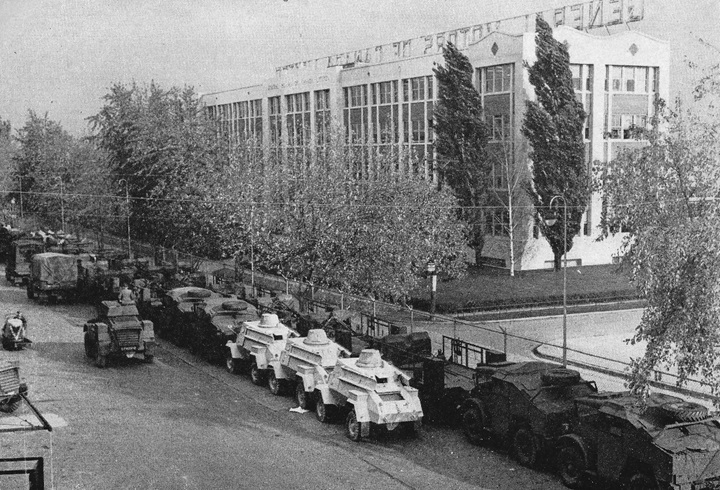
This October 1942 photo shows the street
behind the GM of Canada office building in Oshawa, ONT lined with "Otter"
light reconnaissance cars and Canadian Pattern Military Trucks.
Oshawa built 1,781 of the "Otters" used by the British in
North Africa and Europe.
General Motors of Canada
World War Two Production Statistics: (1,506) Mark 1 "Fox" Armored Cars, (1,781)
"Otter" Light Reconnaissance Cars, (3,961) GM CT15A Armored Trucks, Modified
Canadian Military Pattern Trucks, (201,000) Canadian
Military Pattern Trucks (CMPT), (1,032) De Havilland Mosquito aircraft
fuselages, machine guns, gun sights, anti-tank gun carriages, and
tooling for naval gun mounts and 3.7 cm anti-aircraft gun carriages.
Locations:
Oshawa, ONT - All of the vehicles were built
in this plant. A close read of page 16 of "The Motor Car Business
makes Victory its Business" below indicates that the Oshawa tool room
made the tooling and fixtures for 3.7 cm anti-aircraft gun carriages,
which were then supplied to another company. It also states that
Oshawa supplied tooling and fixtures to an un-named Montreal company which was first to
make mounts for naval guns.
Border Cities plant in Windsor, ONT - This was a Canadian government-owned plant managed by GM of Canada. Built in 1942, the plant
produced 25,000 M1919A4 .30 caliber Browning machine guns.
Walkerville plant in Windsor, ONT - This plant was adjacent to the
Border Cities plant and was first used by GM of Canada in 1919.
During World War Two, it produced naval gun mounts.
Regina, Saskatchewan - Normally a car
assembly plant, this location produced gun carriages for 2-pounder and
6-pounder anti-tank guns. More
information can be found in the "The Motor Car Industry Makes Victory
its Business" below.
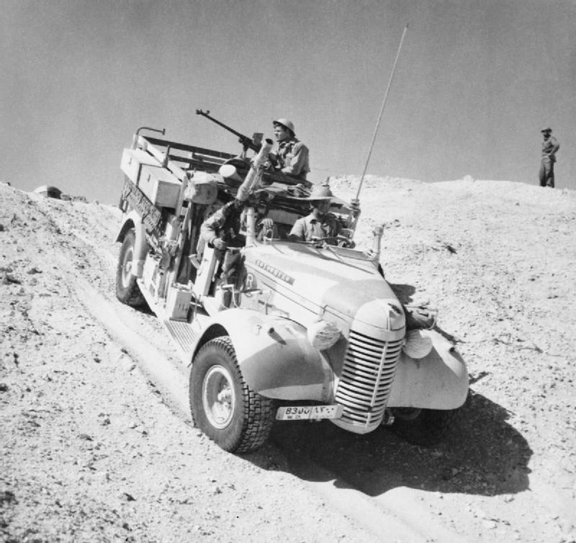
GM of Canada built the Chevrolet 3 ton 4x2
trucks used by the famous Long Range Desert Group in North Africa.
This particular model is a radio truck with a Boys 20mm anti-tank gun
for armament.

De Havilland Mosquito KA 114 is one of 1,032
of this type built by De Havilland during the Second World War at its Downsview
plant in Toronto, Ontario. The aircraft was constructed mostly of
wood, including the fuselages made by General Motors of Canada. It
is one of three flying Mosquito in the world. KA114 is seen here at the 2013 Hamilton,
Ontario Airshow.

This Mosquito's all wooden fuselage, built by the
Mosquito Bomber Group, was on display at the 2006 Selfridge Air National
Guard Base Airshow. GM of Canada made 1,032 wooden fuselages like
this during WWII. Author's photo added 12-24-2015.

This GM of Canada advertisement states that it
is the builder of the all wooden fuselages for the Canadian-built
Mosquitoes. It is unknown which plant built the fuselages.

This GM of Canada radio truck is on display
at the Ontario Regiment Museum in Oshawa, ONT. This truck is 3.6
miles from where it was built in 1943. Author's photo added
1-13-2021.

This is serial number 1 of this type of radio
truck. Author's photo added 1-13-2021.

Author's photo added 1-13-2021.

Author's photo added 1-13-2021.

The radio truck came equipped with a No.19
radio set. Author's photo added 1-13-2021.
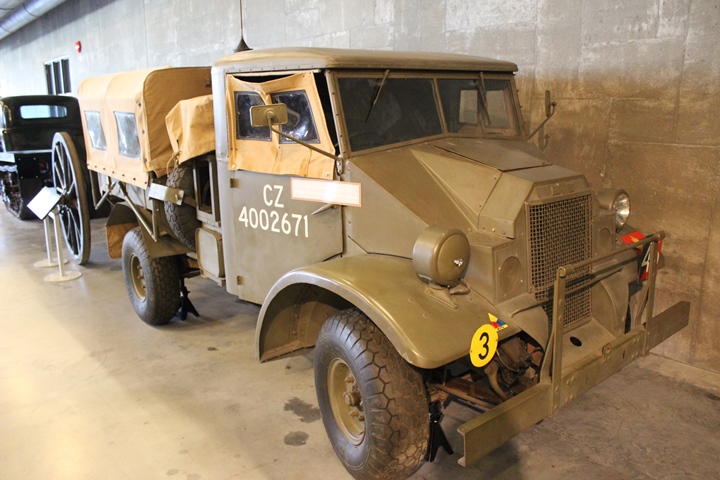
This GM of Canada General Service truck has
a wireless set in the canvas covered body. Author's photo added
2-15-2022.

Author's photo added 2-15-2022.

Besides the wireless set are two operator
chairs. Author's photo added 2-15-2022.
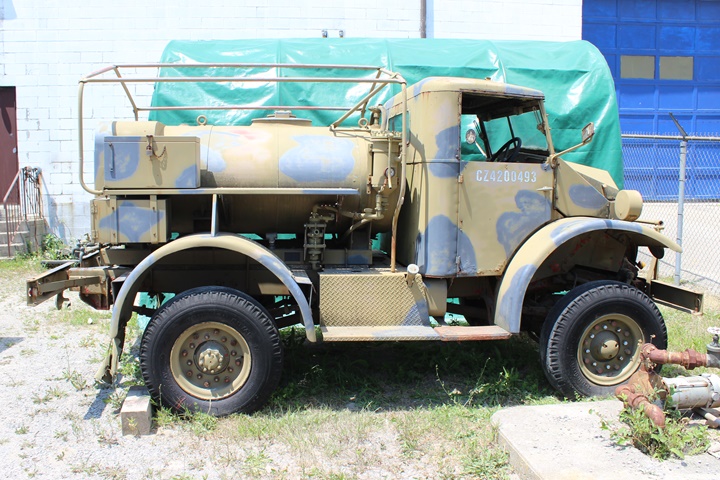
This CMPT at the museum was
also built 3.6 miles away, in the former GM of Canada plant.
Author's photo added 1-13-2021.

This version is a water tanker. Canadian troops could fill their
canteens or other containers from the seven spigots across the rear of
the vehicle. There was also a steel tube overhead structure for a
tarp to keep the sun off the water tank. Author's photo added
1-13-2021.

Author's photo added 1-13-2021.

One of the engine covers is off the of engine
which protrudes into the cab. This is what is known in the
trucking industry as a cab forward design. I think an " engine in
the cab" is more appropriate. Author's photo added 1-13-2021.

Author's photo added 1-13-2021.

This is a GM of Canada-built 15-CWT 4x4
General Service truck. It was part of the reenactment of Sword
Beach at 2019 Conneaut D-Day 75. Author's photo added 8-21-2019.

Author's photo added 8-21-2019.

This photo shows how the engine is covered
as it protrudes into the cab of the vehicle. Author's photo added 8-21-2019.

This GM of Canada C8A 1C1 Heavy Utility
Personnel (HUP) is part of the many vehicles on display at the
Canadian War Museum. Author's photo added 2-15-2022.

The HUP could transport soldiers.
Author's photo added 2-15-2022.

Author's photo added 8-21-2019.

This is a GM of Canada-built 15-CWT 4x4
armored truck. It was on display at the Virginia Museum of
Military Vehicles' 2016 open house. Author's photo added
8-21-2019.

Author's photo added 8-21-2019.

GM of Canada in Regina, Saskatchewan
produced 2-pounder anti-tank guns like this one in the American Heritage
Museum in Hudson, MA. Author's photo added 8-21-2019.

Author's photo added 8-21-2019.

This de-militarized M1919A4 was built by the Borders Industries plant of
GM of Canada during World War Two. It is on display at the Museum
of the Soldier in Portland, IN. Author's photo added 1-13-2021.

It is surprising that this is chambered for
the U.S. Cal .30 rather than for British .303 caliber cartridges.
Author's photo added 1-13-2021.

Author's photo added 1-13-2021.

This 1941 Chevrolet three ton-truck
was built in Oshawa, Ontario as a service truck for the RAF.
Due to the loss of 75,000 of its 80,000 vehicles at Dunkirk, trucks like
these became very important to the British in rebuilding its national
stock of trucks. Manufacturing continued until 1943. Because
the trucks were not four-wheel-drive, many, like this one, were used by
the RAF at its airfields.
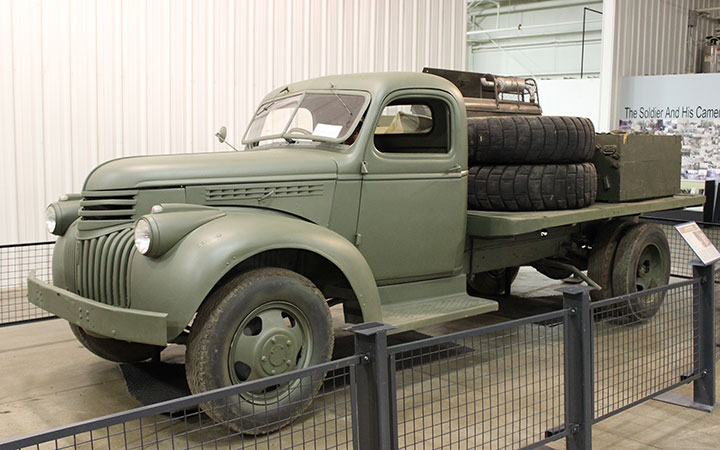

For some reason, when the truck axles were lifted off the floor for
display, the truck did not end up level.


Note that this has right hand steering.

This two page magazine advertisement from
1943
shows all of the vehicles Oshawa produced at that time for the
Commonwealth military forces.

Above (L-R) are water color
renderings of a four wheel drive service truck, a gas tank truck, a
general transport truck, a water tank purifier truck, a staff car, and an
aircraft gas truck.

Starting at the top and working across and
down is an army stores truck, wireless truck, collision
truck, RCAF ambulance, workshop on wheels, RCAF fire truck, dump truck,
broadcast and receiving truck, and then 36 others on the "secret" list.
One of those is the armored ambulance pictured below.

This armored ambulance that could carry four
stretchers was built late in the war.

The Canadian War Museum in downtown Ottawa
has an armored ambulance on display. Author's Photo added
1-8-2017.

Author's Photo added 1-8-2017.

Author's Photo added 1-8-2017.
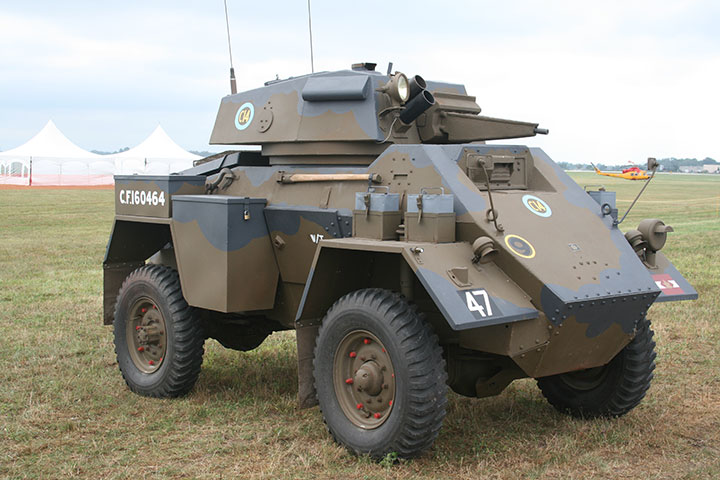
This Fox armored car, seen at 2009 Windsor,
Ontario Airshow, was designated as a GM MK.1. It was another product of
GM of Canada. Chevrolet designed the chassis, GMC Division supplied the
270 cubic inch gas powered engine from the U.S. Final assembly was done by GM of
Canada.

The Fox armored car was built during 1943.

GM of Canada built 1,506 Fox armored cars
for the Canadian Forces. This vehicle and the Otter below are both
on display at the Canadian War Museum. Author's photo added
2-15-2022.

Author's photo added 2-15-2022.

GM of Canada built 1,781 Otter armored cars
during World War Two. The Otter was based on the British Humbler
light reconnaissance vehicle. Author's photo added 2-15-2022.

Author's photo added 2-15-2022.

3,961 CT15A GM of Canada Armored Trucks like
this one were built in 1944 and 1945 for service with
British Empire armies. This would have been another of the 36
"secret" trucks referred to in the 1943 advertisement above.
"The Motor Car Industry
makes
Victory its Business"
This short eighteen page
monograph, published by GM of Canada in December of 1942, gives an
excellent overview of what the Canadian auto industry was doing to
support the war effort. Canada had been
supporting Great Britain, which desperately needed military vehicles and
weapons. The monograph is a reprint of an
article that appeared in the December 1942 issue of Canadian Geographic.
It generally describes the actions of the entire Canadian auto industry,
using GM as the prime example.
The pages below provide information and photos
of the Otter light reconnaissance car that was being built in Oshawa
during 1942. The article also notes that the GM plant in Regina,
Saskatchewan was producing gun carriages for six pounder anti-tank guns.
The Border Cities Industries plant of GM Canada was identified as the
producer of Browning machine guns. The caliber of the weapons was not revealed, as it is considered in 1942 to be a
military secret. McKinnon
Industries Limited, which was separate from GM of Canada as a subsidiary
of GM, is identified as producing fuses for the war effort.


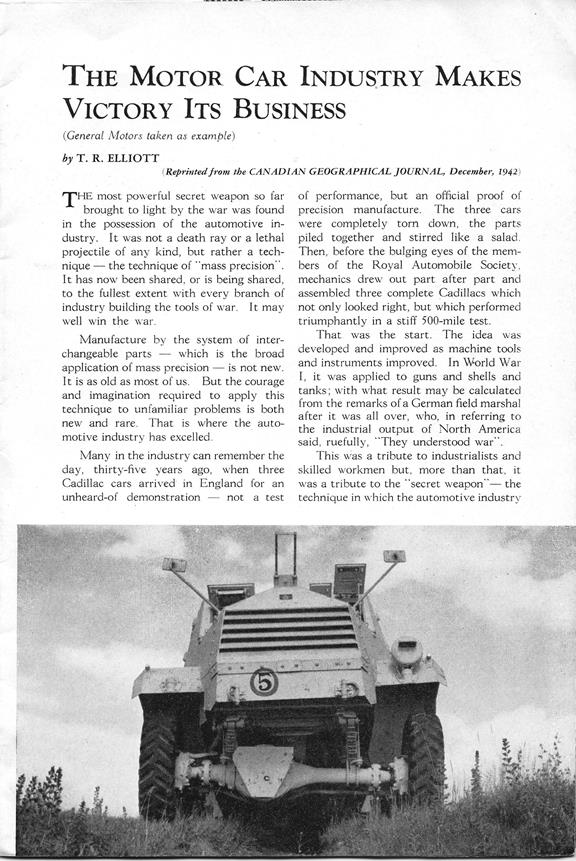
This photo shows the heavy duty front wheel
drive of the Otter.


Half of the items listed on this page were
built by GM of Canada. Those known to have been built by this
Division include armored vehicles, transport vehicles, Browning machine
guns, fuses, aircraft fuselages, and gun carriages.

Coming down the assembly line are two of the
1,781 Otter light reconnaissance vehicles that were produced by GM of
Canada at its Oshawa plant.

Eleven of the Otters have been equipped
with their standard armament of a Bren gun. Others were also armed with a Boys 20mm
anti-tank gun.

During 1942, The Regina plant of GM of Canada
produced the carriages for the six pounder anti-tank gun. The photo
below implies that the plant also built carriages for types of anti-tank
gun, which could have been for the 17 pounder, among others.



The machine is either boring
out the barrel or rifling the bore itself. Using multi-spindle
machines such as this one sped up production. The last paragraph of the text
introduces McKinnon Industries, which was separate from GM of Canada as
a subsidiary of GM, as the manufacturer of fuses for the military.




This 1942 photo shows the fuze final
assembly line at McKinnon Industries. It had a run rate of 375 units per hour.
This is one of two conveyors producing fuses for the
military at a combined output of 750 per hour.





Truck chassis and Otters are seen here after
coming off the assembly line at Oshawa.
|






































































